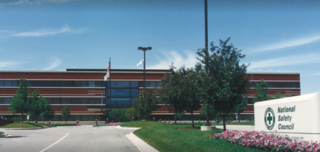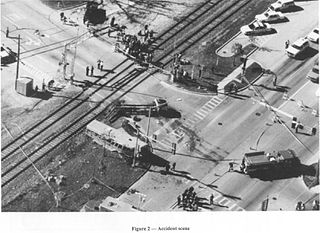
Road traffic safety refers to the methods and measures used to prevent road users from being killed or seriously injured. Typical road users include pedestrians, cyclists, motorists, vehicle passengers, horse riders, and passengers of on-road public transport.
Seat belt legislation requires the fitting of seat belts to motor vehicles and the wearing of seat belts by motor vehicle occupants to be mandatory. Laws requiring the fitting of seat belts to cars have in some cases been followed by laws mandating their use, with the effect that thousands of deaths on the road have been prevented. Different laws apply in different countries to the wearing of seat belts.

Rumble strips are a road safety feature to alert inattentive drivers of potential danger, by causing a tactile vibration and audible rumbling transmitted through the wheels into the vehicle interior. A rumble strip is applied along the direction of travel following an edgeline or centerline, to alert drivers when they drift from their lane. Rumble strips may also be installed in a series across the direction of travel, to warn drivers of a stop or slowdown ahead, or of an approaching danger spot.

A red light camera is a type of traffic enforcement camera that photographs a vehicle that has entered an intersection after the traffic signal controlling the intersection has turned red. By automatically photographing vehicles that run red lights, the photo is evidence that assists authorities in their enforcement of traffic laws. Generally the camera is triggered when a vehicle enters the intersection after the traffic signal has turned red.
Interstate 190 (I-190) is an intrastate Interstate Highway in the U.S. state of Illinois. I-190 runs west from I-90 to O'Hare International Airport, for a distance of 3.07 miles (4.94 km). Interstate 190 is the westernmost leg of the Kennedy Expressway.

The National Traffic and Motor Vehicle Safety Act was enacted in the United States in 1966 to empower the federal government to set and administer new safety standards for motor vehicles and road traffic safety. The Act was the first mandatory federal safety standards for motor vehicles. The Act created the National Highway Safety Bureau. The Act was one of a number of initiatives by the government in response to increasing number of cars and associated fatalities and injuries on the road following a period when the number of people killed on the road had increased 6-fold and the number of vehicles was up 11-fold since 1925. The reduction of the rate of death attributable to motor-vehicle crashes in the United States represents the successful public health response to a great technologic advance of the 20th century—the motorization of America.

A diverging diamond interchange (DDI), also called a double crossover diamond interchange (DCD), is a type of diamond interchange in which the two directions of traffic on the non-freeway road cross to the opposite side on both sides of the bridge at the freeway. It is unusual in that it requires traffic on the freeway overpass to briefly drive on the opposite side of the road from what is customary for the jurisdiction. The crossover "X" sections can either be traffic-light intersections or one-side overpasses to travel above the opposite lanes without stopping, to allow nonstop traffic flow when traffic is relatively sparse.

The National Safety Council (NSC) is a 501(c)(3) nonprofit, public service organization promoting health and safety in the United States. Headquartered in Itasca, Illinois, NSC is a member organization, founded in 1913 and granted a congressional charter in 1953. Members include more than 55,000 businesses, labor organizations, schools, public agencies, private groups and individuals.

The 1995 Fox River Grove bus–train collision was a grade crossing collision that killed seven students riding aboard a school bus in Fox River Grove, Illinois, on the morning of October 25, 1995. The school bus, driven by a substitute driver, was stopped at a traffic light with the rearmost portion extending onto a portion of the railroad tracks when it was struck by a Metra Union Pacific / Northwest Line train en route to Chicago.
Interstate 270 (I-270) makes up a large portion of the outer belt freeway in the St. Louis, Missouri metropolitan area. The counterclockwise terminus of I-270 is at the junction with I-55 and I-255 in Mehlville, Missouri; the clockwise terminus of the freeway is at the junction with I-55 and I-70 north of Troy, Illinois. The entire stretch of I-270 is 50.59 miles (81.42 km).
Interstate 155 (I-155) is a north–south spur of I-55 that provides an Interstate connection for the Illinois cities of Peoria and Lincoln. The northern terminus is just east of Peoria, at I-74 exit 101 in Morton. The southern terminus, which is northwest of Lincoln, is located on I-55 at exit 127. The highway is 32.13 miles (51.71 km) long.

Transportation safety in the United States encompasses safety of transportation in the United States, including automobile crashes, airplane crashes, rail crashes, and other mass transit incidents, although the most fatalities are generated by road incidents yearly killing from 32,479 to nearly 38,680 (+19%) in the last decade. The number of deaths per passenger-mile on commercial airlines in the United States between 2000 and 2010 was about 0.2 deaths per 10 billion passenger-miles. For driving, the rate was 150 per 10 billion vehicle-miles for 2000 : 750 times higher per mile than for flying in a commercial airplane.
Sleep-deprived driving is the operation of a motor vehicle while being cognitively impaired by a lack of sleep. Sleep deprivation is a major cause of motor vehicle accidents, and it can impair the human brain as much as inebriation can. According to a 1998 survey, 23% of adults have fallen asleep while driving. According to the United States Department of Transportation, male drivers admit to have fallen asleep while driving twice as much as female drivers.

The Hurt Report, officially Motorcycle Accident Cause Factors and Identification of Countermeasures, was a motorcycle safety study conducted in the United States, initiated in 1976 and published in 1981. The report is named after its primary author, Professor Harry Hurt.

Driving in the United States is a frequent occurrence, with the majority of Americans using private automobiles as their primary form of transportation to their workplace. Each state has the authority to set its own traffic laws and issue driving licenses, although these laws are largely the same and licenses from other states are respected throughout the country. Americans drive on the right side of the road. There are numerous regulations on driving behavior, including speed limits, passing regulations, and seat belt requirements. Driving while intoxicated with alcohol is illegal in all jurisdictions within the U.S.
The AAA Foundation for Traffic Safety is a non-profit, charitable organization based in Washington, DC, that is dedicated to saving lives through traffic safety research and education. Since its founding in 1947, the AAA Foundation has sponsored over 200 projects related to highway safety, covering topics such as distracted, impaired, and drowsy driving; road rage; graduated driver licensing; driver's education and training; and pedestrian safety. The AAA Foundation research agenda is centered on four priority areas: Driver behavior and performance, emerging technologies, roadway systems and drivers and vulnerable road users.

A traffic collision, also called a motor vehicle collision, car accident, or car crash, occurs when a vehicle collides with another vehicle, pedestrian, animal, road debris, or other stationary obstruction, such as a tree, pole or building. Traffic collisions often result in injury, disability, death, and property damage as well as financial costs to both society and the individuals involved. Road transport is the most dangerous situation people deal with on a daily basis, but casualty figures from such incidents attract less media attention than other, less frequent types of tragedy.

A run-off-road collision is a US term for a type of single-vehicle collision that occurs when a vehicle leaves the roadway.

Alcohol-related traffic crashes are defined by the United States National Highway Traffic Safety Administration (NHTSA) as alcohol-related if either a driver or a non-motorist had a measurable or estimated BAC of 0.01 g/dl or above.

People who are driving as part of their work duties are an important road user category. First, workers themselves are at risk of road traffic injury. Contributing factors include fatigue and long work hours, delivery pressures, distractions from mobile phones and other devices, lack of training to operate the assigned vehicle, vehicle defects, use of prescription and non-prescription medications, medical conditions, and poor journey planning. Death, disability, or injury of a family wage earner due to road traffic injury, in addition to causing emotional pain and suffering, creates economic hardship for the injured worker and family members that may persist well beyond the event itself.
















